Are you a Quiet Speculation member?
If not, now is a perfect time to join up! Our powerful tools, breaking-news analysis, and exclusive Discord channel will make sure you stay up to date and ahead of the curve.
The focus of Magic's newest expansion, War of the Spark, is planeswalkers. These have historically lacked what it takes to consistently make a splash in Modern. Walkers are fair cards, after all, and designed for a Standard power level; besides, in a Turn Four Format, successfully integrating a permanent type that tends to cost four and up takes dedication, or just a certain kind of (*ahem* slow) deck. Today, we'll take a closer look at Modern's most snubbed of card categories, and tip our hats to the walkers that help define the format.
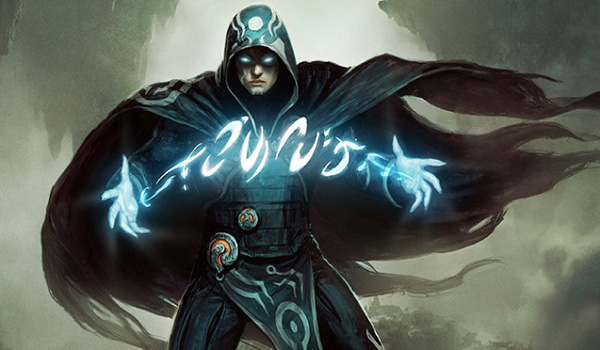
The Planeswalker's Plight
First of all, let's discuss why planeswalkers have such a hard time breaking into Modern. Fundamentally, planesalkers do two things:
- Provide an immediate effect in the form of a small plus or minus
- Provide a bonus effect in the form of snowballing value as the turns roll on
Immediate Effects
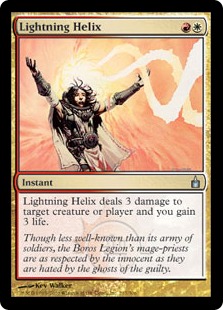 The immediate effect, for planeswalkers to be printable, always costs more than that effect on an instant or sorcery. Take Ajani Vengeant's Lightning Helix at two extra mana, or Gideon Jura's six-mana Vengeance. If the cost of the walker were the same as the cost of the spell it immediately cast, there would be no reason to play the original spell at all.
The immediate effect, for planeswalkers to be printable, always costs more than that effect on an instant or sorcery. Take Ajani Vengeant's Lightning Helix at two extra mana, or Gideon Jura's six-mana Vengeance. If the cost of the walker were the same as the cost of the spell it immediately cast, there would be no reason to play the original spell at all.
Ours is a format centered around mana efficiency, so overpaying for a given effect is especially displeasing for Modern players. And since walkers are always played at sorcery speed, these effects can prove less flexible than when on instants. Whether the additional price is worth paying depends on the value gained from keeping the walker in play rather than just sending it to the graveyard, as we would with an actual sorcery. Viewed through this lens, planeswalkers are sorceries with a non-optional kicker cost that leaves behind the potential for future effects.
Long-Term Value
We'll call that potential long-term value, or LTV. LTV comes in three styles, which each feature some degree of overlap with the others.
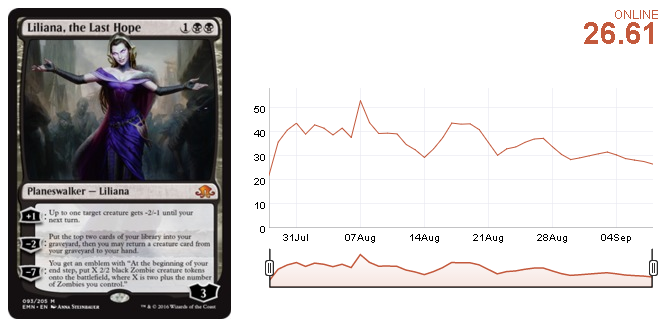 Inevitability. This mode of LTV pressures opponents to deal with the walker by threatening something menacing down the road. That could be re-use of its initial mode, like Liliana of the Veil, or a game-winning ultimate, like Liliana, the Last Hope. Of course, a horde of Zombies might break a midrange slog wide-open, but decks like Storm could care less; therefore, the inevitability of a given effect varies depending on the matchup. Inevitability often takes the form of a "suspend X" effect (e.g. Ancestral Visions), wherein opponents may attack the walker to increase the suspend count.
Inevitability. This mode of LTV pressures opponents to deal with the walker by threatening something menacing down the road. That could be re-use of its initial mode, like Liliana of the Veil, or a game-winning ultimate, like Liliana, the Last Hope. Of course, a horde of Zombies might break a midrange slog wide-open, but decks like Storm could care less; therefore, the inevitability of a given effect varies depending on the matchup. Inevitability often takes the form of a "suspend X" effect (e.g. Ancestral Visions), wherein opponents may attack the walker to increase the suspend count.- Gradual advantage. Walkers that produce advantage each turn fall under this category. Often, these effects involve drawing cards (Sarkhan, Fireblood), creating tokens (Gideon, Ally of Zendikar), or increasing power/toughness (Nissa, Voice of Zendikar). They pressure opponents to deal with the walker before that advantage snowballs into a game-winning threat.
- Static effects. While literal static effects on planeswalkers were introduced for the first time in War of the Spark, some older walkers utilized the same principle. For instance, Gideon of the Trials locked down an enemy threat, as do enchantments like Runed Halo. What's truly new are static effects that hose opponents, such as Ashiok, Dream Render. With Ashiok in play, a type of play pattern becomes impossible for opponents to execute.
As perhaps evinced by the name, long-term value isn't exactly what Modern players look for in a card. How much turn-by-turn value can be generated if the game ends so fast? Since Modern is tempo-centric, and not card-advantage focused, creating a gameplan around snowballing value frequently proves a losing strategy. That, combined with the fact that players must already overpay for their initial walker effects, makes the format a hostile environment for the card type.
Reigniting the Guildpact
Of course, planeswalkers still see use in Modern, which means those that do meet certain thresholds for playability. In Modern Top 5, we try to break down those thresholds and apply them to thematic exemplars with the hope of improving future card analysis.
To assess our walkers, we'll draw from the very first entry in this article series, Modern Top 5: Utility Cards. In other words, we'll use three metrics.
- Power: The degree of impact the card tends to have for its cost.
- Flexibility: The card’s usefulness across diverse situations and game states.
- Splashability: The ease with which Modern decks can accommodate the card.
Power and flexibility will be rated by considering both a card’s floor (the least it will do) and its ceiling (its best-case scenario). For example, Lightning Bolt‘s power floor is higher than Fatal Push‘s, as Push is dead when opponents have no creatures while Bolt can go to the face.
Splashability will be rated by considering how many existing Modern decks can accommodate the card and whether they’ll want it. For example, despite its lack of a color identity, Ghost Quarter doesn’t fit into BGx midrange decks. These decks can easily run Fulminator Mage as mana disruption instead, and prefer not to miss a land drop if they don’t have to.
In the case of power, we'll measure how cheap a walker's initial effect is relative to its sorcery analogue against the relevance of its LTV. Flexibility refers to the walker's applications in different matchups and game states. Each metric will be rated out of 5, giving the card a total rating out of 15. Even if a walker scores low overall, that doesn't mean it's bad or overplayed; just that its uses are somewhat limited in Modern as a whole. Similarly, there are plenty of great walkers not on this list!
#5: Teferi, Hero of Dominaria
Overall: 8/15
Power: 4
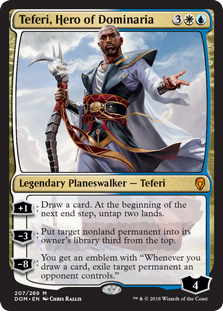 Let's be real—five mana for any of Teferi's immediate effects is a steep price. But the walker does protect himself from menacing creatures, and can start with a relatively high loyalty count if needed. That he costs closer to three mana in practice also increases his power, but further limits his splashability, as few decks can afford to make five land drops before dropping Teferi into play. The walker's effects do everything that UW Control could ever want, providing both inevitability and a stunning amount of gradual advantage.
Let's be real—five mana for any of Teferi's immediate effects is a steep price. But the walker does protect himself from menacing creatures, and can start with a relatively high loyalty count if needed. That he costs closer to three mana in practice also increases his power, but further limits his splashability, as few decks can afford to make five land drops before dropping Teferi into play. The walker's effects do everything that UW Control could ever want, providing both inevitability and a stunning amount of gradual advantage.
Flexibility: 3
Teferi kind of does the same thing every time, which is start putting the game away for UW Control. But the wording on his -3 is a boon for the walker's flexibility. Like Assassin's Trophy, another costly multicolor card celebrated for its versatility, Teferi can remove a huge scope of permanent types—planeswalkers, enchantments, you name it (well, not lands). While adding them back to the deck can mean needing to deal with them again, UW can arrange to have an answer by then, and this form of removal doesn't care about clauses like indestructible.
Splashability: 1
Functionally costing three mana or no, the fact remains that Teferi's down-payment price tag is out of reach for most Modern decks. Barring fringe control builds, the only proven strategy that can wield him at all is pure UW Control, a deck already built to manage the battlefield for a game's entirety.
#4: Karn Liberated
Overall: 9/15
Power: 5
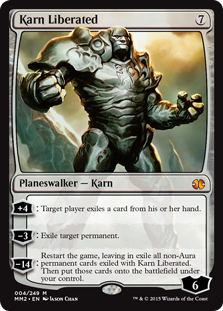 Generally costing a functional three mana thanks to Urza's Tower and its cronies, Karn Liberated boasts a power level obscene enough to single-handedly grant the Tron deck eternal meme status. At any stage in the game, Karn threatens to take at least a player's best permanent; early on, that's a land, and later, it's anything troublesome. Its +4 makes Karn difficult to attack down, and inevitability-wise, the ultimate does guarantee a win—it's just often superfluous anyway. Karn Liberated's abilities offer all three types of LTV.
Generally costing a functional three mana thanks to Urza's Tower and its cronies, Karn Liberated boasts a power level obscene enough to single-handedly grant the Tron deck eternal meme status. At any stage in the game, Karn threatens to take at least a player's best permanent; early on, that's a land, and later, it's anything troublesome. Its +4 makes Karn difficult to attack down, and inevitability-wise, the ultimate does guarantee a win—it's just often superfluous anyway. Karn Liberated's abilities offer all three types of LTV.
Flexibility: 3
As with Teferi, the flexibility here comes primarily from Karn's -3 ability, which permanently removes any permanent. As a pricier walker, Karn's bar for flexibility is a little higher, but it also offers more modes than Teferi: should pilots just want to establish a big board, +4 helps keep Karn alive, and restarting the game can even beat infinite-life and other combos.
Splashability: 1
All good things must come to an end, and splashability is where Karn Liberated really suffers. Only Gx Tron can afford a seven-mana walker. While Karn is a fixture in that deck, and probably not going anywhere in the near future, we're also quite safe to not see him in another strategy.
#3: Karn, the Great Creator
Overall: 10/15
Power: 2
 ...That is, unless it's in a different suit! Karn, the Great Creator features a laughably small power level next to big brother, but more than makes up on our other metrics. Power-wise, Creator suffers in a few ways. Its +1 is only relevant in certain decks, and nothing to write home about regardless. Karn's -2 is as strong as the artifacts lying dormant in the sideboard, but with a catch: pilots need to cast those, too. All that mana quickly adds up, making Karn, the Great Creator a pricey inclusion.
...That is, unless it's in a different suit! Karn, the Great Creator features a laughably small power level next to big brother, but more than makes up on our other metrics. Power-wise, Creator suffers in a few ways. Its +1 is only relevant in certain decks, and nothing to write home about regardless. Karn's -2 is as strong as the artifacts lying dormant in the sideboard, but with a catch: pilots need to cast those, too. All that mana quickly adds up, making Karn, the Great Creator a pricey inclusion.
Still, Modern has quite a few worthy artifacts. Among them is Mycosynth Lattice, the wishboard target that gives Creator so much inevitability: once pilots get to six mana, the artifact combines with Karn's static ability to totally lock opponents out of playing spells by preventing enemy lands from tapping for mana.
Flexibility: 4
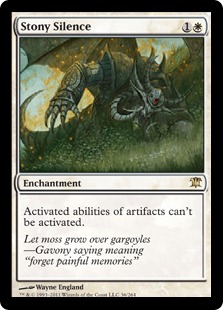 Besides Mycosynth, Karn has a nigh-limitless arsenal at its disposal: artifact hate like Relic of Progenitus; recursive utility like Crucible of Worlds; surgical answers like Sorcerous Spyglass; pseudo-board wipes like Ratchet Bomb. I've enjoyed the walker in Colorless Eldrazi Stompy, a decidedly worse "Karn deck" than Green Tron. Nonetheless, the flexibility Karn provides has turned some bad matchups (Bridge Prison, Hardened Scales, UW, etc.) favorable single-handedly, and at a minimal cost to the deck's already-good matchups.
Besides Mycosynth, Karn has a nigh-limitless arsenal at its disposal: artifact hate like Relic of Progenitus; recursive utility like Crucible of Worlds; surgical answers like Sorcerous Spyglass; pseudo-board wipes like Ratchet Bomb. I've enjoyed the walker in Colorless Eldrazi Stompy, a decidedly worse "Karn deck" than Green Tron. Nonetheless, the flexibility Karn provides has turned some bad matchups (Bridge Prison, Hardened Scales, UW, etc.) favorable single-handedly, and at a minimal cost to the deck's already-good matchups.
Karn's static ability also adds a hearty dose of flexibility, as its "floor" then becomes one of the best sideboard cards in the format, Stony Silence. While only relevant in certain pairings, giving decks the chance to run mainboard Stony at no real cost significantly broadens its appeal.
Splashability: 4
We've already seen Karn make appearances in Green and Eldrazi Tron, decks in which it seems to be a staple; mono-red prison and stompy decks; Eldrazi Stompy, as mentioned; and even combo strategies like Amulet Titan. The card is dominating in older formats, too, especially Vintage. Karn's wide applications in a format with so many great artifacts to choose from, as well as its colorless mana cost, make it a card many decks will continue to both want and be able to play.
#2: Jace, the Mind Sculptor
Overall: 11/15
Power: 4
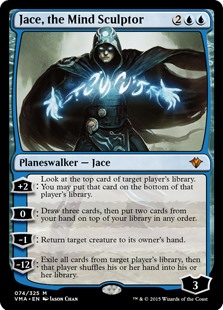 Brainstorm is probably the most powerful cantrip in Magic after Ancestral Recall; AJ Sacher famously called it "too good to be cast." Casting Brainstorm every turn? Now that'll put the game away! Since its unban, Jace, the Mind Sculptor has had far from the format-warping effect its pundits once claimed. But it's still solidified itself as one of Modern's scariest planeswalkers.
Brainstorm is probably the most powerful cantrip in Magic after Ancestral Recall; AJ Sacher famously called it "too good to be cast." Casting Brainstorm every turn? Now that'll put the game away! Since its unban, Jace, the Mind Sculptor has had far from the format-warping effect its pundits once claimed. But it's still solidified itself as one of Modern's scariest planeswalkers.
Besides the incredible gradual value of a repeatable Brainstorm, Jace's -1 protects itself from enemy threats, if badly; Unsummon often plays like treading water, since Jace doesn't generate any value that turn. His +2 is more in line with what players might want to be doing, painfully keeping the game out of reach for opponents while ticking toward an ultimate that will win the game.
Flexibility: 3
 Jace pulls much of his flexibility from his whopping four abilities. In a deck loaded with interaction, Brainstorm itself provides a good deal of flexibility; being able to grow Jace out of damage range with its +2, create gradual advantage both offensively or defensively, impact the board, and eventually win the game by itself also help. But Jace isn't much good at impacting the board, and is a largely miserable play when players find themselves behind.
Jace pulls much of his flexibility from his whopping four abilities. In a deck loaded with interaction, Brainstorm itself provides a good deal of flexibility; being able to grow Jace out of damage range with its +2, create gradual advantage both offensively or defensively, impact the board, and eventually win the game by itself also help. But Jace isn't much good at impacting the board, and is a largely miserable play when players find themselves behind.
Splashability: 4
Jace has made appearances in decks ranging from the control end of the archetype spectrum (UW, Esper) to midrange (Temur, Faeries) to tempo (Kiki-Exarch, Blue Moon) to even combo (Copy-Cat, Breach). Four mana seems a totally reasonable price to pay for such a powerful walker, and the UU color cost manageable for all blue decks.
#1: Liliana of the Veil
Overall: 12/15
Power: 4
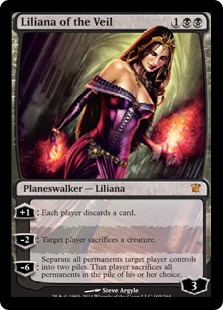 Since her printing, Liliana of the Veil has been Modern's premier planeswalker, and for good reason. Just one more mana for Diabolic Edict, a card we until recently haven't even had legal, is a tiny additional investment for what's left behind. While the -2 pressures creature decks, Lili's +1 forces opponents to play their threats out early, and gives her other applications against critical-mass combo decks.
Since her printing, Liliana of the Veil has been Modern's premier planeswalker, and for good reason. Just one more mana for Diabolic Edict, a card we until recently haven't even had legal, is a tiny additional investment for what's left behind. While the -2 pressures creature decks, Lili's +1 forces opponents to play their threats out early, and gives her other applications against critical-mass combo decks.
Flexibility: 4
As hinted at above, Liliana mostly does it all; she's great on an empty board, where she pressures the hand and prevents creatures from sticking to attack her, and equally great against resolved threats, where she locks in her highest-value ability upon resolution. The -6 can deal with troublesome permanents otherwise out of reach for some color combinations, like Grixis (which can't touch enchantments), or just nuke big boards. It won't win on its own, but many decks still don't want it resolving.
Splashability: 4
As with Jace in blue, any black deck can fit Liliana—and usually does. From Grixis Shadow to Hollow One, not to mention her forever-home in BGx Rock and plenty in between, Lili's got no shortage of couches to watch the game from.
Boots Made for Walkin'
While the established metrics aim to reduce subjectivity in Modern Top 5, a degree of personal preference and bias is impossible to divorce from most any "Top Something" list. In this case, the number ratings on each metric, as well as the selection of metrics themselves, are the most arbitrary element of my process. How do you evaluate planeswalkers? Which do you think are Modern's best? Let's keep the discussion going in the comments!



